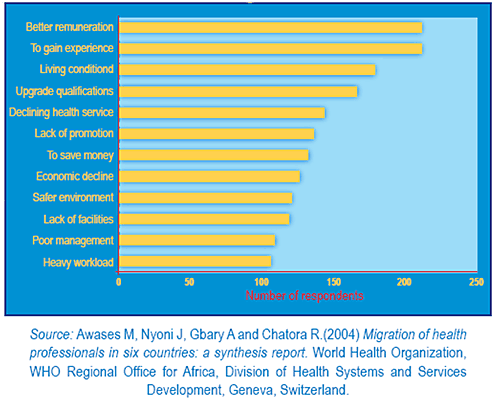- HEALTH TOPICS |
- INT'AL CLASS'N OF DISEASES |
- AIDS GLOSSARY |
- ANATOMY |
- DRUGS |
- USA STATS |
- CHINA STATS |
- GENOME DICTIONARY |


HEALTH TOPICS A TO Z
Migration of health workers
Who are health workers?
Health workers are all people whose main activities are aimed at enhancing health. They include the people who provide health services -- such as doctors, nurses, pharmacists, laboratory technicians -- and management and support workers such as financial officers, cooks, drivers and cleaners. Worldwide, there are 59.8 million health workers. About two-thirds of them (39.5 million) provide health services; the other one-third (19.8 million) are management and support workers. Without them, prevention and treatment of disease and advances in health care cannot reach those in need.
Why health workers migrate
Workers tend to go where the working conditions are best. Income is an important motivation for migration, but not the only one. Other reasons include better working conditions, more job satisfaction, career opportunities and the quality of management and governance. Political instability, war, and the threat of violence in the workplace also are strong drivers in many countries.
Migration is often stepwise. People sometimes move from the poorest regions to richer cities within a country and then to high-income countries. In most countries, there is also movement from the public to the private sector, particularly if there are considerable differences in income levels.
Globalization certainly has helped to drive migration abroad. At the same time, demand for health workers has increased in high-income countries because wealthy countries are not producing enough health workers locally and their existing workforce is ageing; yet there is a growing need for health care because of the ageing of populations and the rise of chronic illnesses like diabetes and heart disease. Another stimulus to migration is the growth of professional recruitment agencies.
In a number of middle-income countries with good medical education systems--such as Fiji, Jamaica, Mauritius and the Philippines--a significant proportion of students, especially in nursing school, enter their education with the intention of migrating, usually in search of a good income. Some countries, notably the Philippines, are seeking to capitalize on the demand for imported health workers by deliberately producing graduates for international export.
Impact of migration
The movement of health workers abroad has positive features. Each year, migration generates billions of dollars in remittances (the money sent back to home countries by migrants) to low-income countries and has therefore been associated with a decline in poverty. Health workers also may return, bringing significant skills and expertise back to their home countries.
Nonetheless, when significant numbers of doctors and nurses leave, the countries that financed their education lose a return on their investment and become unwilling donors to the wealthy countries to which their health personnel have migrated.
Financial loss is not the most damaging outcome, however. When a country has a fragile health system, the loss of its workforce can bring the whole system close to collapse, with the consequences measured in lives lost. In these circumstances, the calculus of international migration shifts from brain drain/gain to "fatal flows."
Health systems in a number of industrialized countries depend heavily on doctors and nurses who have been trained abroad. English-speaking countries draw the lion's share of health workers from overseas. In Canada, New Zealand, the United Kingdom and the United States, a quarter or more of all physicians have been imported from other countries.
On average one in four doctors and one nurse in 20 trained in Africa is working in OECD countries. Some countries have been hit harder than others. For example, 29% of Ghana’s physicians are working abroad, as are 34% of Zimbabwean nurses.
Selected reasons for migration in 4 African countries (Cameroon, South Africa, Uganda, Zimbabwe)

|
TACKLING MIGRATION: WHAT IS NEEDED
Exporting countries:
- Protection and fairer treatment of health workers, who face difficult and often dangerous working conditions and poor pay in many developing countries.
- Training of health workers specifically for rural postings, and development of policies that facilitate the return of migrants.
Importing countries:
- Reduced dependency on migrant health workers in industrialized countries. The main solution is to train more health workers at home. The United States, for example, trains 30% too few physicians to fill its own needs.
- Bilateral agreements with exporting countries aimed at softening the financial impact of migration of health workers.
- Responsible recruitment policies by industrialized countries and fair treatment of migrant health workers.
International agreements:
- Joint investment in research and information systems critical for enhancing the performance of the health workforce.
- Agreements on ethical recruitment of and working conditions for migrant health workers, and international planning of the health workforce for humanitarian emergencies and global health threats such as an influenza pandemic
- Commitment from donor countries to assist crisis countries with their efforts to improve and support the health workforce. Of all new donor funds for health, 50 percent should be dedicated to strengthening health systems, and 50 percent of those funds dedicated specifically to the health workforce.
Sources: US Department of Health; The World Health Organization
- Please bookmark this page (add it to your favorites)
- If you wish to link to this page, you can do so by referring to the URL address below.
https://allcountries.org/health/migration_of_health_workers.html
Copyright © 1995-2020 Photius Coutsoukis (All Rights Reserved)







